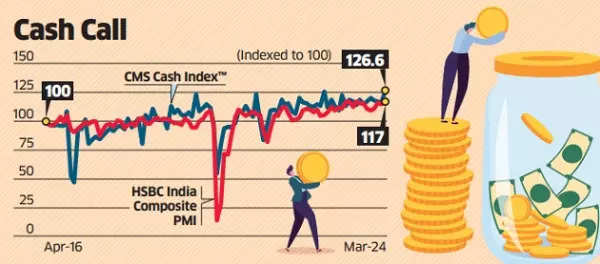The amount of
cash
circulating in the economy has seen a significant increase since the financial year 2016-17, which marked the
demonetisation
and the introduction of
UPI
. Despite the phasing out of Rs 2000 notes, the
currency in circulation
has risen from Rs 13.35 lakh crore in March 2017 to Rs 35.15 lakh crore by the end of March 2024. This means that the cash in circulation has more than doubled since FY 2016-17.
This growth has occurred even though the central bank decided to withdraw Rs 2000 denomination banknotes from circulation in May 2023, resulting in 97.83 percent of the Rs 3.56 lakh crore worth of notes being returned to the banking system, states an ET report by Gayatri Nayak.
The
HSBC PMI
and
CMS cash index
have shown a parallel movement, indicating that cash remains as crucial as digital modes of transactions. UPI, launched in 2016, gained significant traction after the COVID-19 pandemic in 2020, with monthly transaction values increasing nearly nine-fold from Rs 2.06 lakh crore in March 2020 to a record Rs 18.07 lakh crore in February 2024.
Cash In Circulation
The Reserve Bank’s assessments reveal that the demand for currency tends to be higher during festive seasons, prior to major elections, or in years when the agricultural sector experiences strong growth, as it drives cash demand from rural areas.
The CMS Info System’s CMS cash index, which provides cash management and other business services, has shown a strong correlation with the HSBC Purchase Manager’s Index since its inception in 2017. From April 2017 to March 2024, the CMS cash index increased from 100 to 125.6, while the HSBC PMI rose from 100 to 117 during the same period, highlighting the significant relationship between economic activity and cash expenditures.
Anush Raghavan, President of Cash Management Solutions at CMS Info Systems, emphasized the crucial role of cash payments in the overall payments ecosystem, stating, “For an economy to flourish, it is imperative that the payments ecosystem allows all modes of transaction. Cash payments are an indispensable complement to mobile, electronic, and other forms of
digital payments
.” He further noted the importance of this balance in a consumption-driven economy like India, where spending power directly impacts the overall economic well-being.
Raghavan pointed out that smaller economies such as Brazil, South Africa, Russia, and the UK had significantly lower volumes of Currency in Circulation (CiC) compared to larger economies like the United States, China, Japan, and India, indicating a direct correlation between CIC and the size of the economy.
The CMS Cash Index, a weighted index comprising two factors – cash replenishment via ATM channels and cash collected from organized retail channels post-consumer purchases – is covered by CMS Info Systems across various cities and towns in India.
According to CMS Info Systems’ Consumption Report 2024, titled ‘Unfolding India’s Consumption Story 2024,’ consumer spending is increasing in the consumer durables, FMCG, travel, and entertainment sectors, with these sectors leading growth in FY’24. The report also revealed that Delhi, Tamil Nadu, Uttar Pradesh, West Bengal, and Karnataka experienced the highest growth in ATM withdrawals for spending in FY24.


